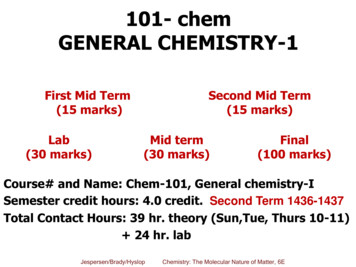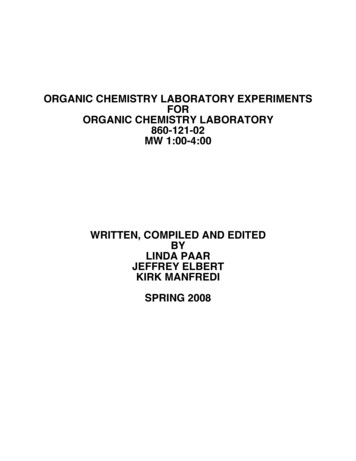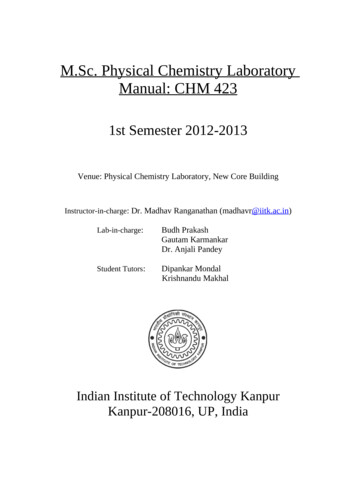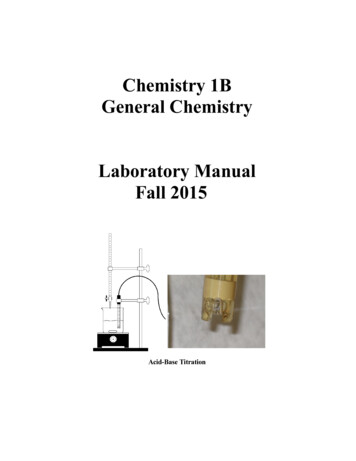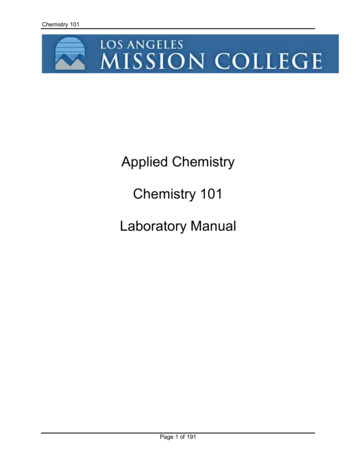
Transcription
Chemistry 101Applied ChemistryChemistry 101Laboratory ManualPage 1 of 191
Chemistry 101PreparedByMaria FenyesEditedbyCharles MalloryPage 2 of 191
Chemistry 101Table of ContentsTable of Contents .3Syllabus .5EXPERIMENT 1: The Balance.7EXPERIMENT 2: Density. 11EXPERIMENT 3: Determination of the Empirical Formula of a Compound . 17EXPERIMENT 4: Table Salt from Baking Soda. 23EXPERIMENT 5: Analysis of a Mixture of NaHCO3 and NaCl . 27EXPERIMENT 6: Net Ionic Equations . 33EXPERIMENT 7: Conductance in Solutions. 43EXPERIMENT 8: The Activity Series . 57EXPERIMENT 9: Standardization of a Base . 65EXPERIMENT 10: Analysis of Vinegar . 73EXPERIMENT 11: Stoichiometry Involving a Gas Collected Over Water . 79EXPERIMENT 12: Thermochemistry; Heat of Reaction. 85EXPERIMENT 13: Separation of Cations by Paper Chromatography . 103EXPERIMENT 14: Atomic Emission. 111EXPERIMENT 15: The preparation and properties of NaHCO3 . 129EXPERIMENT 16: The Effect of Temperature on Solubility . 139EXPERIMENT 17: Chemical Bonding and Molecular Polarity. 145EXPERIMENT 18: Crystal Structure . 153EXPERIMENT 30: Percentage of Copper in Malachite. 164EXPERIMENT 31: Table Salt from Soda Ash. 170EXPERIMENT 32: Equivalent Mass Determination in Oxidation Reduction Reactions. 174EXPERIMENT 33: Standardization of a Sodium Hydroxide Solution with a Primary Standard . 180APPENDIX I – Electronegativity of The Elements . 188APPENDIX II – The Periodic Table . 190Page 3 of 191
Chemistry 101Blank PagePage 4 of 191
Chemistry 101SyllabusActivityTour of the laboratory, Laboratory ProceduresProper Use of Laboratory NotebookSafety VideoExperiment #1: The BalancePeriodic Table of the Elements (Video)Check InExperiment #2: Density; Part 1 and Part 2Video: The Volumetric PipetteExperiment #2: Density; Part 3Experiment #3: Determination of the Empirical Formula of a CompoundExperiment #4: Table Salt from Baking SodaExperiment #5: Analysis of a mixture of Table Salt and Baking SodaExperiment #6: Net Ionic EquationsFirst Laboratory ExamExperiments 1, 2, 3, 4, 5, and the Periodic Table VideoYou may consult your Laboratory NotebookExperiment #7: Conductance in SolutionsExperiment #8: The Activity SeriesExperiment #9: Standardization of a BaseExperiment #10: Analysis of VinegarExperiment #11: Stoichiometry involving a Gas Collected over waterExperiment #12: ThermochemistryExperiment #12: Thermochemistry continued (calculations)Second Laboratory ExamExperiments 6, 7, 8, 9 and 10You may consult your Laboratory NotebookExperiment #13: Separation of Cations by Paper ChromatographyExperiment #14: Atomic EmissionExperiment #14: Atomic Emission continued (calculations)Experiment #15: The preparation and properties of NaHCO3Experiment #15: The preparation and properties of NaHCO3 continuedExperiment #16: The Effect of Temperature on SolubilityExperiment #17: Chemical Bonding and Molecular PolarityExperiment #18: Crystal StructureExperiment #18: Crystal Structure continuedCheck outLaboratory FinalExperiments 9, 10, 15, 41, 42, Temp and CrystalYou may consult your Laboratory NotebookPage 5 of 191ReportPointsUnknownPoints 10 55 101010 20 20 2020101020 10 10 20 20102020 15 10
Chemistry 101Blank PagePage 6 of 191
Chemistry 101EXPERIMENT 1: The BalancePURPOSE:1. To learn to use the different types of balances which are available in thelaboratory.2. To learn the capabilities of the different types of balances which are availablein the laboratory.3. To relate the concept of significant numbers to the accuracy of mass andvolume measurements.PRINCIPLES:One of the most important operations in a chemistry laboratory is the massing ofobjects. Since chemistry is an exact science, the massing of substances whichenter or result from a chemical change must be done with the best possibleaccuracy.Balances differ in capacity and accuracy and the type of balance used in aparticular experiment depends on the accuracy desired for that experiment.For rough massings, where an accuracy of 0.1g is required, the platformdecigram balance may be used. The centigram balance is conveniently usedwhen an accuracy of 0.01g is required.Semi quantitative and some quantitative massing is commonly performed on themilligram balance, which reads to the nearest 0.001g The most accuratebalances commonly used in the modern laboratories for accurate quantitativework are the analytical balances. While they are simple to use, they are also themost delicate and expensive.The reliability of any balance depends upon how it is treated by the user, butspecial care is required in treating the analytical balance. For long balance life,certain general rules must be observed:1. Keep the balance clean. Clean up any spills on, in, or near the balance,immediately.2. Tare (zero) the balance prior to taking any measurements. Wait for thebalance to indicate that it has been tarred prior to placing material onthe balance.3. Never place any chemical directly on the balance pan: always use apiece of weighing paper. Liquids must be weighed in a closed container.4. When an analytical balance is used, the objects being massed shouldbe handled with forceps or crucible tongs.5. Objects being massed must always be at room temperature to avoid aircurrents forming which can affect the accuracy of the massmeasurements. When using the analytical balance, always make surethat the windows of the balance are closed.Page 7 of 191
Chemistry 101PROCEDURE:1. Mass of standard mass on an analytical balance:Obtain a metal strip of known mass from your instructor and record itsidentification number. Determine its mass on the analytical balance and recordthe result. The mass you obtain should agree with the posted mass within0.0005g. Calculate the Percent Error in your measurement by using thefollowing formula:Experimental Value Theoretical ValuePERCENT ERROR Theoretical ValueX 100%Note: Typically the percent error has no sign ( / ); it is typically given as anabsolute value.2. The mass of a Penny:Using the difference scales available; determine the mass of the same penny.Record these masses and indicate the accuracy in each measurement. State thenumber of significant figures in each measurement.3. The density of a metallic cylinderObtain a metallic cylinder and record the material it composed of (brass,copper steel, or aluminum.) Using your ruler, measure the diameter (d) and theheight (h) of the metallic cylinder to the nearest 0.1 mm. Calculate the volumeof the metallic cylinder using the formula, V pr2h. (Recall that 2r d.)Determine the mass of the cylinder using the centigram balance.Calculate the density of the metallic cylinder. (Recall that d m/V.)Calculate the Percent Error in your density determination knowing that thetheoretical values of the cylinder densities are:Brass: . 8.50 g/cm3Copper:. 8.96 g/cm3Steel: . 7.86 g/cm3Aluminum: . 2.70 g/cm3Page 8 of 191
Chemistry 101Experiment 1: THE BALANCEREPORT FORMNAME: Date: Partner(s):1. Mass of Standard Mass on Analytical BalanceI.D. NumberExperimental Mass (g)Theoretical Mass (g)% Error2. Mass of PennyBalanceMass (g)Number ofSignificantFiguresNumber ofCertain DigitsNumber ofUncertainDigitsUncertainty( / ) gDecigramCentigramMilligram3. Density of a Metallic ObjectType of Object:Diameter: (cm)Radius: (cm)Volume: (cm3)Mass: (g)Experimental Density: (g/cm3)Theoretical Density: (g/cm3)% Error %(show your work):Page 9 of 191Height: (cm)
Chemistry 101Questions:1. Good laboratory techniques should provide you with a percent error of less thanfive (5) percent. If you obtained an error greater than five (5) percent, explainbelow what was the source of this error below. (If your error was less than five(5) percent, write “N/A” in the space provided.)2. If an analytical balance is available, why would you ever use the centigrambalance?3. Which of the balances used provided the greatest number of significant digits formass of the penny?Known Masses for Part 1K1 – 1.1877 gK2 – 0.9824 gK3 – 2.0557 gK4 – 2.0675 gK5 – 2.3550 gK6 – 1.5289 gK7 – 1.5957 gK8 – 1.2437 gK9 – 1.6022 gK10 – 1.4881 gK11 – 1.8690 gK12 – 1.6382 gK13 – 1.9364 gK14 – 1.5274 gK15 – 1.6186 gK16 – 1.2153 gK17 – 1.6696 gK18 – 2.0222 gK19 – 1.7287 gK20 – 1.9237 gPage 10 of 191
Chemistry 101EXPERIMENT 2: DensityPURPOSE:1. To provide practice with various measuring devices such as: rulers, balances,volumetric pipettes, and burets.2. To collect data from which problems dealing with physical properties may besolved.3. To calculate the density of various substances by measurements of length,volume and mass of objects.PRINCIPLES:Density is a physical property of a substance and is often used as an aid to itsidentification. Density (D) is defined as the ratio of the mass (m) of a substanceto the volume (v) occupied by that mass;MassDensity VolumeormD VThe units of density are: g/cm3 or g/mL (1 cm3 1 mL)While the mass of a substance is invariable, the volume occupied by thesubstance varies with the pressure and temperature to which it is subjected.Density therefore will also vary with pressure and temperature. The density ofgases is affected by temperature and pressure more than liquids, while sol idsare affected the least. The effect of pressure on the density of liquids and solidsis negligible for most considerations. The pressure effect will not be examined inthis experiment.PROCEDURE: Day 1 1. Density of glass.a. Measure and record the mass of a glass rod on the centigram balance.b. Add approximately 20 25 mL of water to a 50 mL buret.c. Carefully read the liquid level at the bottom of themeniscus to the nearest 0.05 mL, making sureyour line of sight is horizontal.Note:The correct way to read the volume of aliquid is to hold the graduated cylinder withthe meniscus at eye level as shown in thedrawing. Always read the level of the liquidat the bottom of the meniscus.Page 11 of 191
Chemistry 101d. Next, tilt the buret and carefullylower the glass rod to thebottom of the buret. Removeany air bubbles that mayappear.e. Read and record the finalwater level in the buret.f. From this volume change, andthe known mass, calculate thedensity of the glass rod andrecord it on your report form.2. Thickness of Aluminum FoilThe volume of a rectangular solid is given by the product of its length, widthand depth (thickness). If the object's density and mass are known, itsthickness can be calculated if the length and width are measured.a. Obtain a rectangular or square sheet of aluminum foil (whichever isavailable in the laboratory).b. Measure the length and width of the foil to the nearest 0.05 cm, using along ruler or a meter stick. Record your data on the report form.c. Fold the foil several times and weigh it on the analytical balance.d. Use your data and the density of aluminum (2.70 g/cm3) to calculate thethickness of your foil.e. Record the thickness of the foil in centimeters, meters and micrometers.Page 12 of 191
Chemistry 101 Day 2 3. Density of a liquidThe density of a liquid can be determined from its massand an accurately measured volume using a volumetricpipette. A volumetric pipette is simply a glass tube withan enlarged barrel. The tip of the pipette is constrictedand the upper part of the pipette tube has a calibrationmark to which it is filled. When the pipette is filled andthe liquid level (the bottom of the meniscus) is at thecalibration mark, the pipette will deliver the indicatedquantity of liquid.NOTE:THE PIPET IS NEVER FILLED BYMOUTH SUCTION BUT ONLY BYUSING A RUBBER SUCTION BULBa. Before use, the pipette must be clean. This can be checked by filling thepipette with water and allowing the liquid to drain. No water drop letsshould be observed on the inner walls.b. Your volumetric pipette is calibrated TO DELIVER (TD) the indicatedamount of liquid, e.g. 10.00 mL (to the nearest 0.02 mL), by gravity only.As the pipette drains, hold the tip of the pipette to the inner wall of thecollecting vessel. When the flow of liquid from the pipette is complete, asmall amount will remain in the tip. This type of pipette (TD) wascalibrated taking this into account. This retained liquid is never added totheamountofliquiddelivered by gravity.c. The volume of a givenamount of liquid will usuallyincrease with an increase intemperature,e.g.thevolume occupied by 1000mL of water at 15ºC willoccupy 1002 mL at 25ºC.For this reason pipettes aretypically calibrated at aspecifictemperature(20ºC).d. Obtain an unknown liquidsample from your instructorand record its number.e. Determine and record thePage 13 of 191
Chemistry 101mass a clean dry empty vial and its cap on the analytical balance.f. Carefully pipette 10.00 mL of your unknown into the empty vial. Replacethe cap on the vial.g. Determine and record the mass of the vial and its contents by using theanalytical balance.h. Repeat the above procedure with a second 10.00 mL sample of yourunknown.i. Calculate the density of the liquid for each of the two trials.j.Calculate the average of the two experimentally determined densityvalues.Page 14 of 191
Chemistry 101Experiment 2: DENSITYREPORT FORMNAME: Date: Partner(s):1. Density of GlassMass (g)Initial Volume Reading (mL)Final Volume Reading (mL)Volume (mL)Density (g/mL)2. Thickness of AluminumLength of Foil (cm)Width of Foil (cm)Mass of Foil (g)Thickness of Foil (cm)Thickness of Foil (m)Thickness of Foil (um)3. Density of a LiquidUnknown Number:Sample 1Mass of Vial and Cap (with liquid) (g)Mass of Vial and Cap (without liquid) (g)Mass of Liquid (g)Volume of liquid (mL)Density of liquid (g/mL)Density of liquid (Average) (g/mL)Page 15 of 191Sample 2
Chemistry 101Questions:1. Calculate the percentage error of your experimentally determined density ofglass. (Assume that the density of glass is equal to 2.5 g/mL.)2. Why should you or shouldn’t you blow all of the liquid out of the pipette in section2?Page 16 of 191
Chemistry 101EXPERIMENT 3: Determination of the Empirical Formula of aCompoundPURPOSE:1. To determine the empirical formula of a metallic oxide.PRINCIPLES:The empirical formula gives the relative numbers of the different kinds of atomswhich are present in a compound. We can determine the relative weight of thedifferent elements in a compound if we can synthesize the compound from itselements or analyze the compound to obtain the constituent elements. Fromknowledge of the atomic weights of the different elements, we can determine therelative number of atoms (or moles of atoms) in a given mass of the compound.By combining these Ideas, we can see that in a compound which contains xgrams of element X and y grams of element Y:the number of moles of atom X x gramsAtomic Mass of Xthe number of moles of atom Y y gramsAtomic Mass of YThe relative number of moles of atoms of the elements would then be the ratio ofX to Y. In writing the empirical formula we reduce the ratios of the relativenumbers of atoms to the ratio of the smallest whole numbers, and use thesmallest whole numbers in writing the empirical formula.The relative masses of the different elements in a compound can be obtained bya variety of techniques.In the present experiment, we will oxidize tin with nitric acid and then heat theproduct so that only tin oxide remains. The reaction can be abbreviated as:Sn ¾HNO¾¾3 SnO xwhere x is the key number if the empirical formula is to be determined in thisexperiment.If we know the initial mass of the tin used and the mass of the oxide produced,then the mass of the oxygen present is given by the increase in the mass of thesample. From this data we can then proceed to determine the empirical formulaof the tin oxide which is produced.Page 17 of 191
Chemistry 101SAFETY PRECAUTIONS:The concentrated nitric acid used in this experiment should be kept and used inthe hood. The reaction of tin with nitric acid gives off fumes containing nitrogenoxides which should not be inhaled. Protective safety glasses should be wornand the nitric acid should not be dropped or splattered on oneself.GOGGLES must be worn throughout this experiment.PROCEDURE:1. First you must clean and dry your crucible.a. Wash the crucible and wipe it dry.b. Place the crucible on a clay triangle and heat itgentlyc. Heat for two or three minutes at maximumflame temperature. The tip of the sharplydefined inner blue cone of the flame (hottestpart) should almost touch the crucible bottom.d. Transfer the crucible, using the crucible tongs, to a clean, dry, heat resistant surface to cool.2. Allow the crucible to cool for a minimum of five minutes.3. Mass and record the crucible’s mass to the nearest0.0001 g.4. Place a piece of tin foil massing about 1 gram into yourcrucible.5. Mass and record the mass of the crucible plus the foil to the nearest 0.0001 g.6. Calculate the exact mass of the tin used.7. Place the crucible into the hood and add concentrated nitric acid drop wise to thetin in the crucible. NOTE: The crucible shall not be heated during the addition ofthe HNO3.a. Observe the reaction cautiously after the addition of each portion ofconcentrated nitric acid.b. Do not add the nitric acid so fast that it foams or splatters out of thecrucible.8. After the tin has completely reacted with the nitric acid, the evolution of brownfumes (nitrogen dioxide) will stop.a. When this stage has been reached, the crucible should be placed in theclay triangle on the ring stand in the hood.b. Warm gently the crucible and its contents to evaporate any excessunreacted nitric acid.Page 18 of 191
Chemistry 101c. No more brown fumes of nitrogen dioxide are given off when theevaporation is complete.Warning: Do not heat the crucible strongly before all of the nitric acidhas been evolved because the sample may splatter. Any splatteringwill result in an increased error in your final calculations.d. Heat for a minimum of five minutes at maximum flame temperature. Thetip of the sharply defined inner blue cone of the flame (hottest part) shouldalmost touch the crucible bottom.e. Transfer the crucible, using the crucible tongs, to a clean, dry, heat resistant surface to cool.f. Allow the crucible to cool for a minimum of five minutes9. Mass and record the crucible and its contents to the nearest 0.0001 g.10. Heat the crucible and contents for a minimum of five minutes at maximum flametemperature.11. Transfer the crucible, using the crucible tongs, to a clean, dry, heat resistantsurface to cool.12. Allow the crucible to cool for a minimum of five minutes13. Mass and record the crucible and its contents to the nearest 0.0001 g.a. If the two masses do not agree within 0.0005 g. repeat the heatingprocess again until constant mass is achieved.CALCULATIONS:1. Subtract the mass of the crucible plus tin from the mass of crucible plus tinoxide (constant mass) to find the mass of the oxygen in the tin oxide.NOTE: Constant mass is always taken as the lowest mass.2. Divide the mass of tin by its atomic weight to get the relative number of molesof tin atoms. Do the same for oxygen. Reduce the relative numbers of molesto a whole number ratio. Round off the answer to the simplest whole number.3. Record the empirical formula of the tin oxide you have synthesized.Page 19 of 191
Chemistry 101CLEANING UP:1. The crucibles may be cleaned out by scraping out the loose tin oxide anddissolving any that sticks to the crucible with a few drops of concentratedhydrochloric acid.CAUTION!!!DO THIS IN THE HOODPage 20 of 191
Chemistry 101Experiment 3: Determination of the Empirical Formula of a CompoundREPORT FORMNAME: Date: Partner(s):Mass of crucible: gMass of crucible tin: gMass of tin: gMassif crucible tin oxide: g (Constant Mass)Mass of crucible tin: gMass of oxygen in oxide: gRelative number of moles of Sn atoms: molesMass of 1 mole of Sn: g / moleRelative number of moles of O atoms: molesMass of 1 mole of O: g / moleActual ValueRounded Off ValueNumber of moles of Sn Number of moles of SnNumber of moles of O Number of moles of SnEmpirical Formula of Oxide FormedPage 21 of 191
Chemistry 101Determine the percent error using the number of moles of oxygen divided by thenumber of moles of tin prior to rounding off AND the theoretical value of SnO.Show your work!!Determine the percent error using the number of moles of oxygen divided by thenumber of moles of tin prior to rounding off AND the theoretical value of SnO2.Show your work!!Page 22 of 191
Chemistry 101EXPERIMENT 4: Table Salt from Baking SodaPURPOSE:1. To obtain sodium chloride from sodium hydrogen carbonate2. To study the stoichiometry of this reactionMETHOD:Baking soda is the common name for sodium hydrogen carbonate [NaHCO3].When sodium hydrogen carbonate is treated with hydrochloric acid [HCl(aq)] itproduces a white solid residue (sodium chloride, commonly called table salt) andtwo gaseous products: water vapor and carbon dioxide.GOGGLES must be worn throughout this experiment.PROCEDURE:1.Mass a clean, dry, 50 mL beaker on the centigram balance.2.Remove the beaker from the balance and add approximately1.0g 1.5g of NaHCO3 into the beaker.DO NOT EXCEED THE AMOUNT OF NaHCO3 INDICATED.3.Determine the exact mass of the beaker and its content on the centigrambalance. The exact mass of the NaHCO3 in the beaker may be determined bydifference of this and the empty beaker.4.In the fume hood, measure out 4 5 mL of concentrated hydrochloric acid (12M) in your small graduated cylinder. Record this volume to the nearest 0.1 mL(You must measure out at least 4.0 mL).CAUTION!! CONCENTRATED HYDROCHLORIC ACID IS HIGHLYCORROSIVE AND GIVES OFF NOXIOUS FUMES!5.Transfer the concentrated hydrochloric acid to a small beaker and cover itwith a watch glass. Leave the beaker under the fume hood.DO NOT RETURN ANY CONCENTRATED HYDROCHLORIC ACID TO THEORIGINAL REAGENT BOTTLE.DO NOT REMOVE THE CONTAINER WITH HYDROCHLORIC ACID FROMTHE FUME HOOD.If you measured out too much concentrated hydrochloric acid, dispose of it inan appropriately labeled waste container found in the fume hood.6.While In the fume hood, add drop wise (use a Pasteur pipette) theconcentrated hydrochloric acid to the sample and observe the effervescence.If the effervescence is too vigorous, slow down the rate at which theconcentrated hydrochloric acid is added, to avoid splattering of the sample.Page 23 of 191
Chemistry 101This step is completed when all of the concentrated hydrochloric acid hasbeen added to the sample.7.Heat the beaker under the fume hood until the sample appears dry.If the residue starts to melt (glassy appearance), this indicates that theheating is too strong and the residue had probably been already heated todryness and hence constant mass. Keep in mind that heating is done with thesole purpose to completely drive off the gaseous products, and not to melt theresidue.8.Continue heating at in the hood until constant mass is achieved. (Constantmass will occur when successive massings agree within 0.01 g)9.Record the mass of the beaker and the residue (constant mass) anddetermine the mass of the residue.Page 24 of 191
Chemistry 101Experiment 4: Table Salt from Baking SodaREPORT FORMNAME: Date: Partner(s):DataMass of beaker: gMass of beaker and sample (NaHCO3): gMass of sample (NaHCO3): gMass of beaker and residue first heating: gMass of beaker and residue second heating: gMass of beaker and residue third heating (if required): gMass of residue: gVolume of concentrated HCl added: mLCalculationsMass of 1 mole of NaHCO3: g/moleNumber of moles of NaHCO3 added: molesConcentration of HCl added: MNumber of moles of HCl molesWrite a balanced chemical equation for this chemical reaction.Include all statedesignations for both reactants and products.How many moles of HCl are required to react completely with the NaHCO3 you havemeasured out? molesPage 25 of 191
Chemistry 101Which reactant is limiting?Which reactant is in excess?Actual yield of NaCl: gTheoretical yield of NaCl: gShow calculations below:Percent yield of NaCl %Show calculations below:Page 26 of 191
Chemistry 101EXPERIMENT 5: Analysis of a Mixture of NaHCO3 and NaClPURPOSE:1. To determine the percent of NaHCO3 in a mixture of NaHCO3 and NaCl.2. To separate two substances by a chemical reaction.METHOD:When a mixture of NaHCO3 and NaCl is treated with concentrated HCl, onlyNaHCO3 will react, whereas the NaCl will remain unchanged:NaHCO 3 ( s ) HCl ( aq ) NaCl ( s ) CO 2 ( g ) H 2 O( g )NaCl ( s ) HCl ( aq ) No reactionThe sample of unknown contains two compounds (NaHCO3 and NaCl). Theresidue which results upon addition of aqueous HCl will contain only NaCl. Partof the residue is the original NaCl that was present and the other part is the NaClformed as a result of the reaction between NaHCO3 and HCl.Since:· The mole ratio between the NaCl formed and the NaHCO3 reacted is 1:1(e.g., 1 mole of NaHCO3 produces 1 mole of NaCl)· The molar mass of NaCl is less than the molar mass of NaHCO3· The other products of the reaction (CO2 and H2O) are gases and will belost to the surroundings.Then the residue will weigh less than the original sample and the sample willappear to have “lost mass”.Since the mass loss is proportional to the mass of NaHCO3 originally present inthe mixture, the mass of NaHCO3 can be calculated. The result of this analysis isusually given as the percentage of NaHC03 present in the original sample ofunknown composition.PROCEDURE:1. Obtain a sample (about 1.0 grams) of the unknown (NaCl NaHCO3) mixture.2. Record the unknown number in your Laboratory Notebook.3. Place a clean 50 mL beaker on a wire gauze and heat for threeminutes at maximum flame temperature to remove all moisturefrom the beaker.Page 27 of 191
Chemistry 1014. Allow the beaker to cool to room temperature.5. Mass the cooled beaker on the analytical balance (to the nearest 0.0001 g).6. Add your sample into the beaker.7. Determine the exact mass of the beaker and its contents on the analyticalbalance (to the nearest 0.0001 g).8. Determine the exact mass of the sample in the beaker by difference.9. In the fume hood, measure out 4 5 mL of concentrated hydrochloric acid (12 M)in your small graduated cylinder.CAUTION!! CONCENTRATED HYDROCHLORIC ACID IS HIGHLYCORROSIVE AND GIVES OFF NOXIOUS FUMES!10. Record the volume of the acid to the nearest 0.1 mLNOTE:YOU must measure out at least 4.0 mL of the acid. This willensure that the HCl is NOT the limiting reactant.11. In the fume hood, Transfer the concentrated hydrochloric add to another smallb
Chemistry 101 Page 11 of 191 EXPERIMENT 2: Density PURPOSE: 1. To provide practice with various measuring devices such as: rulers, balances, volumetric pipettes, and burets. 2. To collect data from which problems dealing wi

